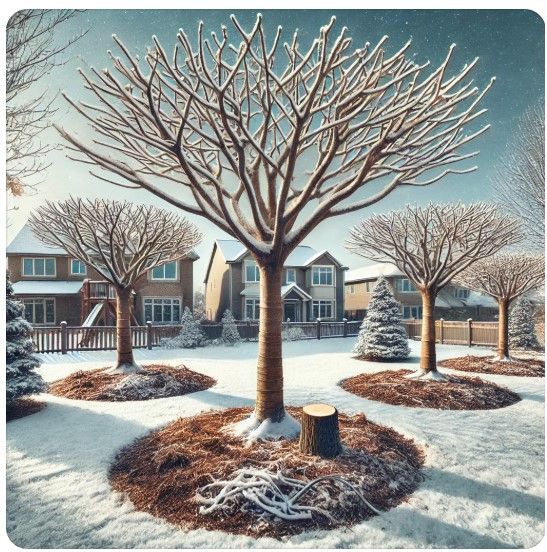Essential steps to ensure your trees withstand the cold months ahead.

Winter Tree Care in Joliet, IL: How to Protect Your Landscape, Prevent Hazards, and Ensure Tree Health This Season
As winter approaches in Joliet, IL, homeowners and property managers are bracing for the cold temperatures, snow, and ice that define the season. While you’re likely focused on heating your home and staying warm, don’t overlook your trees, which face a season of stress and potential damage. Proper winter preparation is key to ensuring your trees survive the harsh conditions and thrive when spring returns.
This guide will provide you with the knowledge and tools you need to protect your trees this winter. From tree removal and stump grinding to storm damage prevention and land clearing, we’ll cover everything you need to know to safeguard your property while being mindful of your budget.
Why Preparing Your Trees for Winter Matters
Trees are a critical part of your property, offering shade, beauty, and environmental benefits. However, winter can be a tough time for them, especially in a region like Joliet where temperatures can dip below freezing, and snow and ice storms are common. Without proper preparation, trees may suffer damage that affects their health or poses safety risks to your home and family.
Common Winter Challenges for Trees in Joliet
Heavy Snow and Ice: These can accumulate on branches, causing them to break or, in severe cases, bring down entire trees.
High Winds: Joliet winters often include windy conditions that can snap weak branches or uproot poorly anchored trees.
Temperature Fluctuations: Sudden freezes and thaws can create cracks in tree bark, a condition known as frost cracking.
Wildlife Damage: Deer, rabbits, and other animals may gnaw on bark during the winter months when food is scarce.
Proactive care and maintenance are the best ways to mitigate these risks and ensure your trees make it through the season intact.
Step 1: Assess the Health of Your Trees
Start by inspecting your trees for signs of weakness or damage. Walk your property and look for:
Dead or Damaged Branches: These are more likely to break under the weight of snow or ice.
Leaning Trees: A leaning tree may have a compromised root system and could fall during a storm.
Cracks or Splits in the Trunk: These are structural weaknesses that may worsen under winter stress.
Signs of Disease: Fungus growth, discolored bark, or unusual leaf drop can indicate health issues.
If you identify any problems, consult a professional tree service to evaluate the situation. Removing a hazardous tree or pruning damaged branches now is far more cost-effective than dealing with emergency damage later.
Step 2: Prune and Remove Deadwood
Pruning is an essential step in winter preparation. Removing weak, dead, or overgrown branches reduces the risk of breakage during storms and helps the tree conserve energy during its dormant phase. Additionally, pruning improves airflow and light penetration, which benefits the tree’s overall health.
Why Pruning in Winter Is Ideal:
Trees are dormant, meaning less stress from the pruning process.
The absence of leaves allows for better visibility of the tree’s structure.
Dormant pruning reduces the risk of pest infestations or diseases entering through fresh cuts.
For large trees or branches near power lines, hiring a professional is the safest option.
Step 3: Protect Tree Roots with Mulch
Mulching around the base of your trees helps insulate the roots from freezing temperatures. It also retains soil moisture, which is essential for tree health during the dry winter months.
How to Mulch Effectively:
Apply a 2–4 inch layer of organic mulch, such as wood chips or shredded bark, around the base of the tree.
Keep the mulch a few inches away from the trunk to prevent rot or pest infestations.
Extend the mulch to the tree’s drip line (the outer edge of the branches).
Mulching is especially beneficial for young trees and newly planted saplings, which are more vulnerable to cold weather.
Step 4: Water Your Trees Before the Ground Freezes
Winter may bring snow, but that doesn’t mean your trees are getting enough water. Ensure your trees are well-hydrated before the ground freezes, as this helps them withstand the dry winter months.
Winter Watering Tips:
Water deeply around the base of the tree, focusing on the root zone.
Avoid watering late in the day to prevent freezing at the soil’s surface.
Evergreen trees, which lose moisture through their needles year-round, often require extra hydration.
A well-watered tree is better equipped to handle winter stress.
Step 5: Wrap Young or Sensitive Trees
Young trees or species with thin bark, such as maples, are prone to sunscald and frost cracking during winter. Wrapping their trunks provides protection from these temperature-related issues.
How to Wrap a Tree:
Use a breathable material, such as burlap or tree wrap.
Start at the base of the trunk and wrap upward, overlapping slightly as you go.
Secure the wrap with twine or tape, but avoid tying it too tightly.
Remove the wrap in early spring to prevent moisture buildup, which can lead to rot.
Step 6: Remove Hazardous Trees and Stumps
Winter storms can exacerbate existing tree hazards, turning them into costly emergencies. Removing dead or diseased trees before winter sets in is a proactive way to prevent damage to your property.
Benefits of Winter Tree Removal:
Safer removal process when the ground is frozen and less prone to damage.
Prevents accidents caused by falling trees or branches during storms.
Opens up space for spring planting or landscaping projects.
Similarly, stump grinding eliminates tripping hazards and prevents pests that can thrive in decaying wood.
Step 7: Prepare for Storm Damage
Even with the best preparation, winter storms can still wreak havoc. Having a plan in place for storm damage ensures you’re ready to act quickly and safely.
Tips for Handling Storm Damage:
Inspect your trees after every storm for new damage.
Avoid parking vehicles or placing outdoor equipment under large trees during storms.
Keep emergency contact information for a trusted tree service on hand.
If a tree falls or poses an immediate threat to your property, call a professional for emergency tree work.
Step 8: Land Clearing for Winter Projects
If you’re planning a construction project or landscaping overhaul, winter is an excellent time for land clearing. Frozen ground minimizes soil disturbance, and clearing during the dormant season avoids disruptions to wildlife habitats.
Reasons to Consider Winter Land Clearing:
Prepares your property for spring planting or building.
Reduces overgrowth that can harbor pests or block sunlight.
Enhances the safety and appearance of your landscape.
Professional land clearing services ensure the job is done efficiently and with minimal environmental impact.
Balancing Tree Care with the Economy
We understand that times are tough for many homeowners, and prioritizing expenses is more important than ever. That’s why we emphasize preventative care. Investing in proactive tree maintenance now can save you from costly emergencies and property damage later. Additionally, maintaining your trees enhances curb appeal, which can boost your property value if you’re considering selling in the future.
Winter is fast approaching, and the time to prepare your trees is now. Don’t let the season’s challenges catch you off guard. Contact JolietTreeGuys.com for professional, reliable tree services tailored to your needs. Our experienced team specializes in tree removal, stump grinding, land clearing, emergency tree work, and storm damage cleanup.
We’re committed to helping you protect your property and maintain the health and beauty of your trees, all while being mindful of your budget. Visit JolietTreeGuys.com or call us today to schedule a consultation.
Protect your landscape, prevent hazards, and enjoy peace of mind this winter—reach out to JolietTreeGuys.com now for expert care and exceptional service. Don’t wait until it’s too late. Let us help you prepare your trees and safeguard your property this winter!

New Paragraph
Copyright 2024 JolietTreeGuy.com. All Rights reserved.
Designed by KDesign




